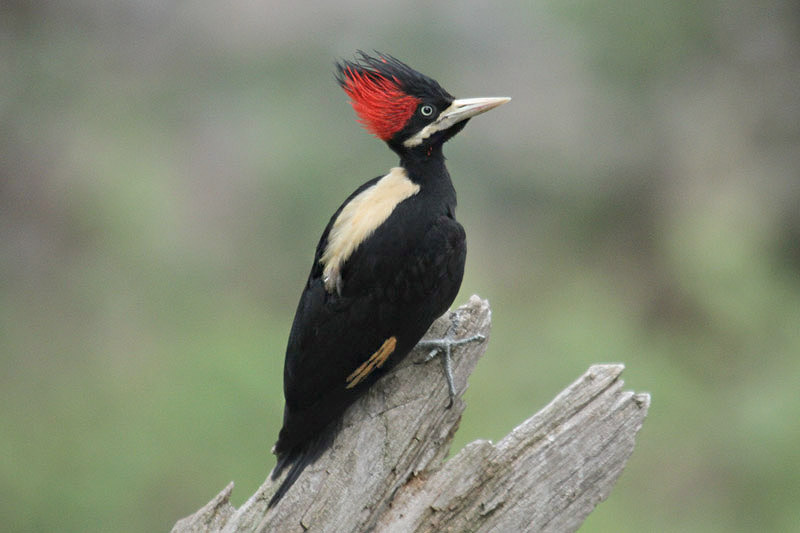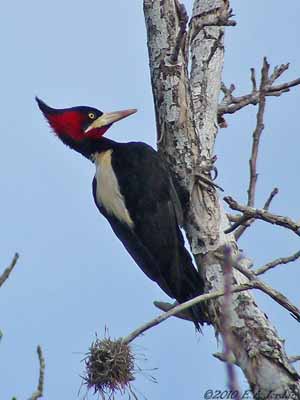Cream-backed Woodpecker
White coat Woodpecker ( male )
The white coat Woodpecker ( Campephilus Leucopogon ) is a neotropical species has in the genus Campephilus. It is found in Bolivia, Paraguay, Uruguay, Argentina and Brazil.
Features
The white coat woodpecker reaches a size of 28 to 30 cm and a weight of 203-281 g The male has a small, oval, black and white spot on the lower rear ear-coverts. The rest of the head and the hood are red. Red pen tips are seen in variable distances along the neck. In worn plumage they turn black. The mantle feathers are white with light beige - cinnamon-colored tips. Behind the back and upper tail-coverts are black. Sometimes the center back has some schwarzgebänderte yellow-brown feathers. The upper wings are black. The hand and arm swings have a large bright cinnamon-colored area towards the bases of the inner webs. The tail top and bottom are black. The lower wings are black, light cinnamon at the bases of the hand and arm swing and whitish to pale cinnamon to the under wing-coverts at the front edge of the wing. The long, ivory-colored beak is straight, chisel-shaped and very wide over the nostrils. The iris is bright yellow, the legs are gray. The female has a longer hood than the male. The areas of the forehead to the middle of the hood, around the eyes and along the rear ear-coverts are black. A black -lined, wide, cream-colored cheek stripe runs from the beak base to the lower ear-coverts. Neck and upper chin are black. The juvenile birds the head is more orange and less intense red color. The young male resembles the adult female, apex and hood but are more red and the white cheek stripe is interspersed with red feathers. The chin is more black. In the young female the red coloration on the hind crown and the back of the group is limited.
Vocalizations
The call is a "pi -ow " or " kwee - yaw", which is sometimes repeated. In encounters between partners, whirring sounds are heard. The drumming is a double rap.
Habitat
The habitat includes dry forests in the Gran Chaco, savannas, grasslands with shrubs, trees and forests in the transition zone at altitudes up to 2500 m.
Food behavior
Outside the breeding season the white coat woodpecker lives solitarily. The diet consists of beetle larvae. He goes into great trees, isolated trees in open areas and fallen tree trunks in search of food, which he brings out the larvae by powerful hammering from the bark. Pecking and drilling are less common.
Reproductive behavior
The breeding season is mainly in September, but can extend into October and November. The nest box is built in 6 to 8 m high in a tree or a palm tree. The nest hole is teardrop-shaped. Both parents care for the nestlings. Information on clutch size, incubation period and fledging period are not available.
Status
BirdLife International classifies the white coat woodpecker as " not at risk " ( least concern ). Inventory data, there is little, he probably is rare. The white coat woodpecker occurs in several protected areas, including in the Parque Nacional El Rey National Park Calilegua and the Parque y reserva natural Chancaní in Argentina.










